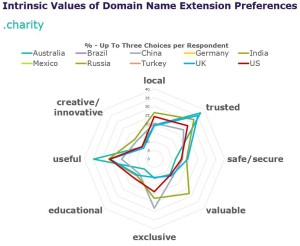
Beyond Dot-com: New Top-Level Domains Gain Support Around the Globe
A global study on how consumers use the internet found that, while established top-level domains like “.com” and “.org” continue to rule cyberspace, new TLDs are gaining traction among web users.
A global study on how consumers use the internet found that, while established top-level domains like “.com” and “.org” continue to rule cyberspace, new TLDs are gaining traction among web users.
You may love your dot-coms and your dot-orgs, but a new survey of internet users found that there is a growing market around the world for new domain name extensions. The one-year-old Domain Name Association commissioned the international study [PDF], which asked respondents to react to a variety of top-level domain names (TLDs), from generic (gTLDs) to country code (ccTLDs) to yet-to-be-created TLDs.
The goal was to determine how consumers throughout the world perceive different TLDs. For example, when shopping for shoes online, would a person be more likely to go to the website shoes.com, shoes.[country], or shoes.shop? More than 2,500 respondents in seven countries completed the survey, and DNA said it is still compiling data in at least three more countries.
“Legacy gTLDs and ccTLDs still command the respect of the survey panels, of course, but many examples of new extensions caught the imagination of respondents,” DNA said in a newsletter announcing the survey’s findings. “A strong attraction for geographical (city) names surfaced in the survey, as well as evidence that domain names that have particular meaning will be appealing and resonant with users.”
For the most part, respondents in the U.S. favored websites ending in “.com,” while other countries, including Australia, China, India, and the U.K., preferred new TLDs and ccTLDs. DNA said the finding wasn’t surprising, given how well established and widely used gTLDs and ccTLDs are in those countries. But the data showed that acceptance of new TLDs is growing.
Respondents were also asked to look at several new TLDs and identify what intrinsic values they would associate with them. For example, a majority of respondents said a website using the “.charity” TLD was useful, trusted, and local.
(Image source: Domain Name Association Internet Study)
Data from the survey confirmed that there’s work to be done to create awareness of new TLDs. Only 24 percent of respondents said they were aware of efforts to expand the number of domain names, 57 percent said they were unaware, and 19 percent were unsure. But the survey found plenty of support for increasing the number of available domain names: 61 percent said there should be more options, and 39 percent said there should be few or no changes to domain names.
(iStock/Thinkstock)







Comments